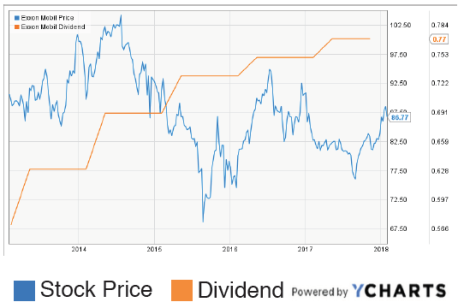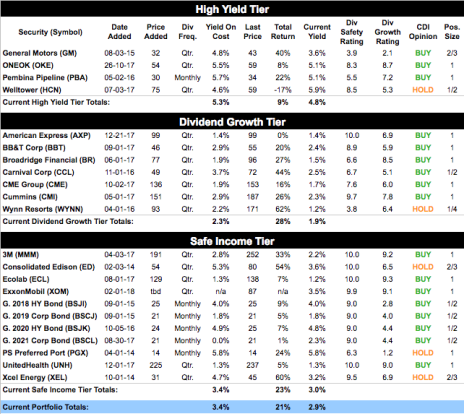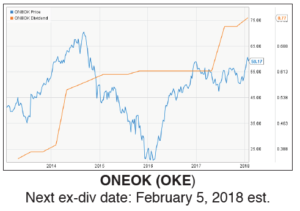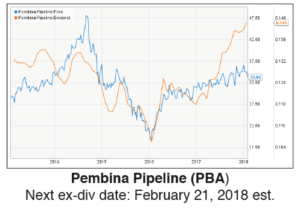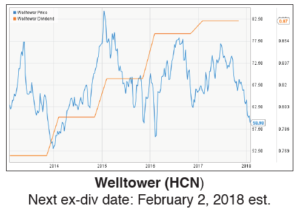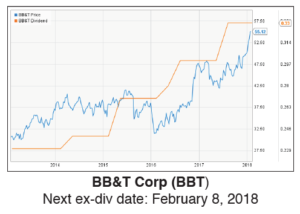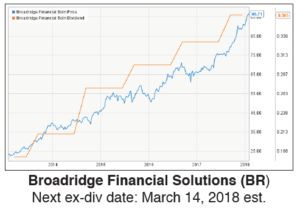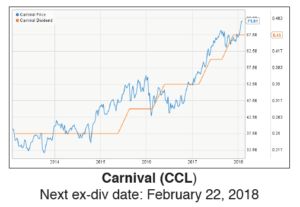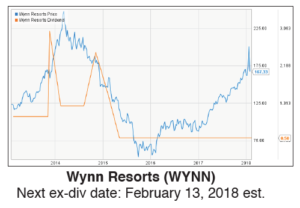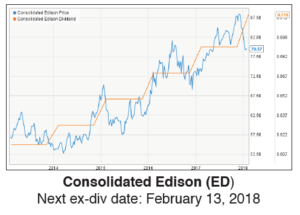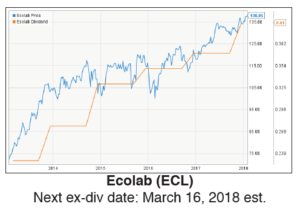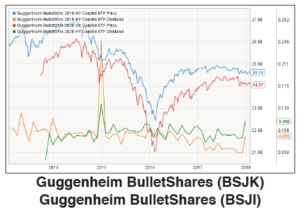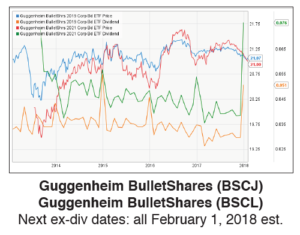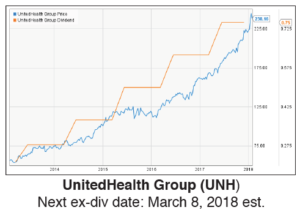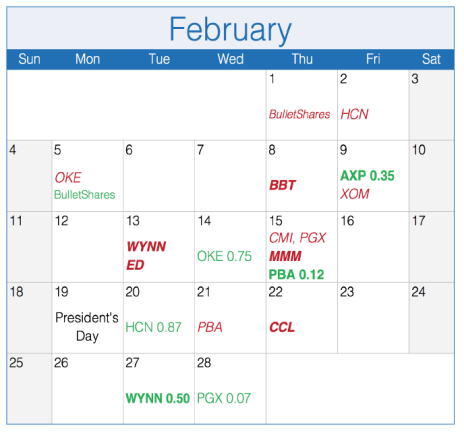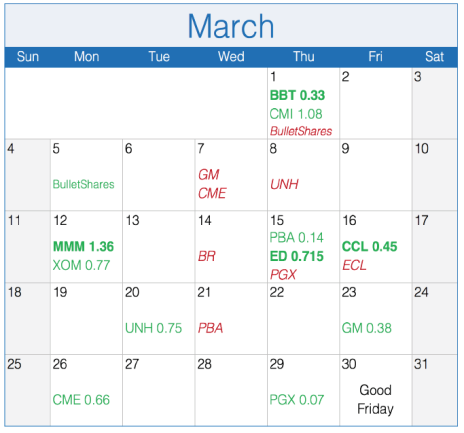The title of today’s issue is “Don’t Overreact”—the major trend of the market is still up, and there are many signs pointing to higher prices in the months ahead. Chloe adds a new stock to the Safe Income Tier and presents her view on the forces affecting interest rates and income investments today.
Cabot Dividend Investor 118
[premium_html_toc post_id="143891"]
Don’t Overreact
After closing at record highs on Friday, the major indexes finally started to pull back this week. The pullback is making headlines because even 1% dips in the market have been so rare recently, but it’s still quite minor—and completely expected after such a strong rally.
Some analysts blame rising interest rates for the abrupt return of skepticism to the stock market. Conventional wisdom says rising rates will eventually push stocks lower, and the yield on the 10-year treasury rose over 2.7% on Monday for the first time since 2014. But the key word here is eventually—interest rates and stocks can rise in tandem for years.
In the meantime, economic data remains strong; consumer spending, jobless claims and mortgage application numbers all beat expectations last week. Earnings season is off to a very good start, with 81% of S&P 500 components beating estimates so far. And the tax bill is prompting a raft of analyst upgrades of 2018 earnings, which should contribute to higher stock prices over the next year.
There are reasons to be cautious. In addition to the market’s breakneck advance, volatility is increasing, especially among individual stocks. On the other hand, January does tend to be more volatile than your average month, as big investors reposition themselves for the new year.
[highlight_box]What To Do Now: In short, while the market is ripe for a correction, and this one could go much further, most evidence is still pointing up. Limit your buying to the healthiest stocks and sell anything that needs to be sold—stocks that are significantly underperforming the market or in which your loss hits your limit—but don’t overreact this week. In our portfolio, we’re adding some energy exposure to the Safe Income Tier, and we sold another half of our Wynn Resorts (WYNN) shares yesterday. [/highlight_box]
Featured Buy
Exxon Mobil (XOM)
Energy stocks lagged the market for most of 2017, as the industry struggled to recover from years of low oil prices. But the sector found its footing about six months ago, and is now poised for outperformance in 2018 thanks to the highest oil prices in three years. Because the recovery is still young, many high-quality energy stocks still offer high yields, and today, I’m adding 3.5%-yielding Exxon Mobil (XOM) to the Safe Income Tier.
The Company
Texas-based Exxon Mobil is one of the world’s largest oil and gas companies, producing more oil than any other non-state-owned oil company. In addition to exploration and production sites on six continents, Exxon owns and operates a vast web of refineries, a massive chemicals-manufacturing operation, over 10,000 gas stations, and many more energy-related businesses.
From 2012 to 2016, as oil prices slipped from north of $100 per barrel to under $30, Exxon’s revenues were cut in half. Earnings per share fell by 80%.
Both are now recovering. Revenues started growing again in the last quarter of 2016, and EPS beat estimates in three of the last four quarters. In the latest quarter, reported in October, EPS rose by 50% year-over-year. Still well below their peaks of five years ago, revenues and earnings are now growing by double digits.
Exxon’s 2017 earnings report is due on February 2 before the market opens. Analysts are expecting to see a 23% jump in sales in the last quarter of the year, and 16% higher EPS than in fourth quarter 2016. Full-year 2017 revenues are expected to have risen 20%, contributing to a whopping 55% expansion in EPS.
The earnings expansion is expected to continue in 2018: analysts are currently forecasting 14% sales growth and 23% EPS growth over the next 12 months. And over the next five years, analysts expect EPS growth to average 21% per year.
The Stock
Despite this impressive earnings growth, XOM remains undervalued compared to its peers. The stock trades at a P/E of 29 and a forward P/E of 22. By contrast, Chevron’s (CVX) current and forward P/E ratios are 38 and 27. ConocoPhillips’ forward P/E is 40, and the stock’s current P/E can’t be calculated because its EPS are still negative.
And XOM has underperformed the energy sector over the past two years, rising 10% compared to the Energy SPDR’s 33% gain.
Partially that’s because Exxon didn’t crash as hard as most peers during the energy selloff. XOM fell less than 30% from peak to trough, compared to a 45% slide for Chevron and a 60% decline for ConocoPhillips. So it makes sense that Exxon’s recovery over the past year hasn’t been as impressive as its peers’.
Some of Exxon’s underperformance can also be attributed to sanctions imposed in 2014 that have prevented the company from consummating a 2012 deal with Russian oil company Rosneft. The deal would have allowed Exxon to explore and drill for oil in Siberia, the Black Sea and the Russian Arctic in exchange for providing Rosneft with cold-water drilling technology. But the sanctions, imposed after Russia annexed Crimea in 2014 and a Malaysian passenger plane was shot down over the territory, prohibit technology transfers for Russian energy projects as well as dealings with Rosneft CEO Igor Sechin. Concern that Exxon’s Rosneft deal will expire before the sanctions are lifted has contributed to downward pressure on Exxon this year.
I can’t tell you what will happen to the Rosneft deal—and even if I could, investing based on what you think Washington will do is always a mistake. But XOM’s recent action suggests that investors are getting over their disappointment about the Russia deal, and that a new era is finally beginning.
The stock started the year with a gap up to new 52-week highs, surpassing 87.5 for the first time since January 2017. XOM is still below its highs from 2016, which could act as overhead resistance. But momentum is good and a rotation into energy stocks is likely to provide a significant tailwind to the stock this year. The entire sector is benefiting from a rebound in oil prices, which are now at their highest level in three years.
The Dividend
In addition to offering a better value than most peers, Exxon earns a spot in our portfolio for its unparalleled dividend history.
Exxon has paid dividends every year since 1970, and has increased the dividend in each of the last 35 years. Exxon was one of the few major oil companies to continue increasing its dividend during the 2014-2015 oil price crash. The stock’s payout ratio did reach 138% last year, but has declined as earnings rebounded over the past year, and is now down to 83%. That’s the second-lowest payout ratio of the oil supermajors (after Total, TOT).
Together with analysts’ strong earnings estimates, Exxon’s dividend history earns the stock a Dividend Safety Rating of 9.9 and a Dividend Growth Rating of 9.1, both out of 10.
For its high and reliable yield and the likelihood of capital gains in 2018, I’ll be adding Exxon Mobil (XOM) to our Safe Income Tier at tomorrow’s average price.
| Exxon Mobil (XOM) | ||
|---|---|---|
| Price: 87 52-week range: 76.05-89.30 Market cap: $367.98 billion P/E: 29 | Current yield: 3.5% Annual dividend: $3.08 Most recent dividend: $0.77 Dividend Safety rating: 9.9 Dividend Growth rating: 9.1 | |
| Dividends since: 1970 Consecutive years of increases: 35 Qualified dividends? Yes | Payment Schedule: Quarterly Next ex-dividend date: February 9, 2018 est. | |
Portfolio at a Glance
Portfolio Updates
High Yield Tier
The investments in our High Yield tier have been chosen for their high current payouts. These ?investments will often be riskier or have less capital appreciation potential than those in our other ?two tiers, but they’re appropriate for investors who want to generate maximum income from their? portfolios right now.
BUY – General Motors (GM 43 – yield 3.6%) – GM continues to chop around between 41 and 46. The car company will report fourth-quarter and full-year 2017 results on February 6 before the open. Earnings estimates for GM have been rising and analysts now expect 2017 EPS to rise 3.6%, to $6.34, despite a 12.6% decline in revenue to $145.47 billion. Fourth-quarter revenue is also expected to decline, falling to $36.55 billion, 16.8% below 2016’s record, when auto sales peaked. But thanks to cost controls and increased profitability, EPS are expected to rise 7.8% to $1.38, up from $1.28 last year. GM remains a Buy for investors who are interested in the stock’s 3.6% yield and decent medium-term growth potential.
BUY – ONEOK (OKE 59 – yield 5.1%) – OKE is healthy. After breaking out of its trading range to the upside in mid-January, the stock rose to its highest level since 2014 and is now pulling back normally. OKE spent the past 12 months consolidating, so any new rally could be a big one. The natural gas pipeline operator recently released strong 2018 earnings guidance and will probably report earnings towards the end of February. OKE is a good buy here for both yield and medium-term gains.
BUY – Pembina Pipeline (PBA 34 – yield 5.1%) – PBA extended its pullback this week to close at its 200-day moving average yesterday. The stock’s gently-sloping long-term uptrend remains intact and previous pullbacks have presented good buying opportunities, so I’ll keep PBA on Buy for yield-oriented investors. Pembina is a Canadian company (that pays monthly dividends in Canadian dollars) with an extensive network of oil and gas processing and transportation infrastructure. The company has been growing steadily through acquisitions and capital investment and analysts expect EPS to grow by double-digits this year and next. Pembina will report 2017 results before the open on February 23.
HOLD – Welltower (HCN 59 – yield 5.9%) – Welltower will report fourth-quarter results before the open on February 22. Analysts expect the health care REIT to report normalized FFO per share of $1.05 for the quarter and $4.24 for the full year (while REITs must report EPS, FFO or funds from operations provides a more accurate picture of cash flow.) The stock is trading near 52-week lows, support is dicey and rising interest rates are a major risk. We’re holding for now but won’t hesitate to sell the second half of our position if HCN continues to deteriorate.
Dividend Growth Tier
To be chosen for the Dividend Growth tier, investments must have a strong history of dividend increases and indicate both good potential for and high prioritization of continued dividend growth.
BUY – American Express (AXP 99 – yield 1.4%) – After its post-earnings drop (earnings were strong but AmEx reported a large one-time charge related to the tax bill that dinged its capital ratio), AXP bounced off its 50-day moving average last week and has made up most of its losses. AmEx’s decision to suspend share buybacks to rebuild its capital ratio before the 2018 stress tests could slow the stock’s momentum over the next six months, but the long-term uptrend is still intact. And business is good; income from loans, fees and interest are all trending up. Long-term investors can still buy AXP here for growth and income.
BUY – BB&T Corp (BBT 55 – yield 2.4%) – BBT has spent the past week consolidating, after popping to new all-time highs after reporting 2017 earnings. Rising interest rates are working in BB&T’s favor, and are expected to provide a tailwind through 2018. The company’s taxes are also going down, and CEO Kelly King said they plan to pass about a third of the savings on to investors through dividend increases. Analysts have been increasing their 2018 earnings estimates quickly, which should support more share price gains. Dividend growth investors can buy some here.
BUY – Broadridge Financial Solutions (BR 96 – yield 1.5%) – BR remains near all-time highs, undeterred by this week’s market pullback. Short-term, it could be a little extended; the stock’s 50-day moving average is way down at 91. But the strength is a very bullish sign. Broadridge will report second-quarter earnings on February 8 before the open (the company’s fiscal year ends in June.) Analysts expect EPS growth of 38.5%, from $0.39 to $0.54, and revenue growth of 5.2% to $938.98 million. Broadridge provides technology and services, like portfolio management tools and proxy vote processing, to financial firms. The company is growing by expanding its offerings and client list. Dividend growth investors can buy on pullbacks.
BUY – Carnival (CCL 72 – yield 2.5%) – CCL broke out to a new all-time high on Thursday, the first time the company has surpassed its September pre-hurricane level. The stock has followed through on the breakout nicely, suggesting that this could be the start of a strong new rally. While the market pullback of the past two days does present the risk of a relapse into its trading range, I’m going to go ahead and put CCL back on Buy today. Earnings are growing by double digits, and 2018 bookings are well ahead of last year’s pace. A recent industry report predicted that 27 million people will take a cruise in 2018, one million more than last year. As the largest cruise company, with 10 cruise lines serving passengers all over the world, Carnival benefits from any growth in the industry. Carnival is also a significant driver of demand growth; the company sponsors three cruise-themed reality TV shows and recently developed its first Spanish-language show, which reunites long-separated families on board Carnival ships. Dividend growth investors can buy a little CCL here for medium-term capital appreciation and dividend growth.
BUY – CME Group (CME 153 – yield 1.7%) – CME operates some of the world’s largest financial exchanges, where investors trade futures, options and other derivatives. The stock is in a healthy uptrend and recently bounced off its 50-day moving average. CME will report fourth-quarter earnings tomorrow, February 1, before the market opens. Analysts expect fourth-quarter revenue and EPS to slip 3.3% and 4.4% respectively (to $882.8 million and $1.09 per share), due to low volatility and low trading volumes at the end of the year. But both revenue and EPS are expected to rise for the full year, revenue by 1.0% to $3.63 billion and EPS by 4.9% to $4.75, up from $4.53 last year. Investors primarily interested in growth as well as dividends that rise steadily over time can start positions here.
BUY – Cummins (CMI 187 – yield 2.3%) – Cummins makes heavy duty engines used in trucks, construction equipment and other industrial and transport applications. Industrials are doing well thanks to strong economic growth at home and abroad, and the stock hit another new all-time high on Monday before pulling back with the market yesterday. Momentum is strong, but CMI is rather extended short-term, so consider waiting for a pullback toward the 50-day moving average, now at 175, before buying. The company will report earnings on February 6 before the open. Analysts expect fourth-quarter sales to hit $5.2 billion, up 16.2%, and EPS to reach to $2.66, up 18.2%. For the full year, EPS are expected to rise 24.7% to $10.26, while sales are expected to rise 15.0% to $20.1 billion.
HOLD – Wynn Resorts (WYNN 171 – yield 1.2%) – As explained in yesterday’s Special Bulletin, Wynn Resorts CEO Steve Wynn has been accused of serially harassing female employees at his Las Vegas properties in an article published by The Wall Street Journal on Friday. Wynn has denied the allegations, but the company’s stock fell 18% following the report. While the pullback is large, percentage-wise, the stock remains above its 50-day moving average and is at about the same level it was trading two weeks ago before fourth-quarter results were released. However, because the fallout of the allegations is likely to be long-lived, we sold half our shares yesterday, at the day’s average price of 166.51, for a profit of 79%. That brings our remaining position in Wynn down to one-quarter of our standard position size, following a previous sale in August. We’ll hold the remaining shares for now. The stock found some support yesterday, and could stabilize here, around its 50-day moving average. However, more downside is equally possible. The Nevada Gaming Commission has opened an investigation into the allegations, and regulators in Massachusetts and Macau may follow suit soon. Penalties could include fines, the revocation or non-renewal of one or more of Wynn’s gaming licenses, or require Steve Wynn to step down. Even if regulators decide not to take action, investors may avoid the shares while investigations are ongoing. If WYNN continues to fall, we’ll take the rest of our profits and walk away.
Safe Income Tier
The Safe Income tier of our portfolio holds long-term positions in high-quality stocks and other investments that generate steady income with minimal volatility and low risk. These positions are appropriate for all investors, but are meant to be held for the long term, primarily for income—don’t buy these thinking you’ll double your money in a year.
BUY – 3M (MMM 252 – yield 2.2%) – 3M hit a new all-time high after reporting estimate-beating earnings on Friday. The industrial conglomerate’s revenues rose 9.0% in the fourth quarter, beating estimates by $110 million. Adjusted for a one-time impact from the tax bill, EPS were up 11.7% year-over-year, and beat estimates by 3%. Full-year sales of $31.7 billion also beat expectations and were 5% higher than in 2016. And full-year adjusted EPS of $9.17 beat estimates by 7 cents and were 12.4% higher than 2016 EPS. Management also increased its 2018 guidance significantly thanks to the lower tax rate taking effect this year. Lastly, 3M raised the quarterly dividend by 16% to $1.36 per quarter. That’s about in line with 3M’s typical annual 15% dividend increase. All is well at 3M, but try to buy on pullbacks toward the 50-day moving average, currently at 237.
HOLD – Consolidated Edison (ED 80 – yield 3.6%) – ED has traded sideways all week, which is good news for a utility these days. The fact that the stock didn’t lose more ground even as the 10-year rate hit 2.7% suggests that expectations of higher rates may have peaked for now. ConEd will report 2017 earnings on February 15 after the close. Analysts are expecting fourth-quarter EPS of $0.77 and revenue of $2.8 billion, up 13.2% and 3.4% year-over-year. For the full year, analysts are expecting revenue of $1.94 billion, down 1.1%, and EPS of $4.09, up 3.3%. ED remains a Hold for long-term safe income.
BUY – Ecolab (ECL 138 – yield 1.2%) – ECL hit a new all-time high last week, and is now in a gradual intermediate-term uptrend. The industrial company will release fourth-quarter and full-year results on February 20 before the open. Analysts are expecting to see 7.5% revenue growth and 12.0% EPS growth in the quarter, to $3.6 billion and $1.40 per share. For the full year, analysts are expecting revenue of $13.79 billion and EPS of $.469, up 4.8% and 7.3%. Ecolab isn’t setting the world on fire, but the company’s recurring revenue streams and single-digit earnings growth have funded 31 consecutive years of dividend increases. Long-term investors can buy some here.
BUY – Guggenheim BulletShares 2018 High Yield Corporate Bond ETF (BSJI 25 – yield 4.0%)
BUY – Guggenheim BulletShares 2019 Corporate Bond ETF (BSCJ 21 – yield 1.8%)
BUY – Guggenheim BulletShares 2020 High Yield Corporate Bond ETF (BSJK 25 – yield 4.8%)
BUY – Guggenheim BulletShares 2021 Corporate Bond ETF (BSCL 21 – yield 2.3%)
These four funds make up our bond ladder, which is a conservative strategy for generating income. The funds pay distributions monthly, and mature at
the end of the year in their name, at which point Guggenheim disburses the net asset value of the ETF back to investors. That makes the bond ladder a good store of value and source of reliable income for the most conservative portion of your portfolio. If you’d like to construct your own bond ladder, you can use a mix of investment-grade and high yield funds, as we have, or pick one or the other. The high yield funds own junk-rated debt and yield more, of course, but are also more likely to see some of their holdings default (and to be volatile when credit conditions get dicey). If you roll the proceeds into a longer-dated fund every time a fund matures, you’ll create a reliable income stream that can rise with interest rates over time.
HOLD – PowerShares Preferred Portfolio (PGX 14 – yield 5.8%) – As expected, PGX has pulled back towards 14 this week, reflecting the rise in interest rates. Long-term investors can continue to hold for income; PGX has low volatility and is unlikely to drop more than 5% to 10%. Last time rates spiked, in the fourth quarter of 2016, PGX corrected as far as 14 before eventually rebounding. In the meantime, PGX’s monthly dividends keep flowing. Hold.
BUY – UnitedHealth Group (UNH 237 – yield 1.3%) – UNH gapped down about 4% yesterday amid a sudden selloff in health insurer stocks. Investors were responding to news that Amazon, Berkshire Hathaway and J.P. Morgan will join forces to create their own health plan for their 1.2 million combined employees. With retailers and grocery stores still reeling from Amazon’s disruption of their industries, the news made healthcare investors understandably skittish. However, the selloff is likely an overreaction, considering that all the three have done so far is issue a press release. It’s still far from clear what form their endeavor will take, and what effect it will have on large health insurers like UnitedHealth, which insures over 40 million people. For now, I’m going to keep UNH on Buy, since this selloff will probably blow over quickly.
HOLD – Xcel Energy (XEL 45 – yield 3.2%) – XEL is trading sideways, and remains a Hold for long-term safe income investors. Xcel Energy is a Minnesota-based electric utility that has invested heavily in renewable energy, making the company the largest generator of wind power in the U.S. Xcel will report 2017 results on February 7 before the market opens. Analysts expect revenue of $2.9 billion and EPS of $0.43 in the fourth quarter, up 5.2% and down 4.44%. For the full year, revenues are expected to hit $1.6 billion while EPS are expected to rise 4.5% to $2.31.
Dividend Calendar
Ex-Dividend Dates are in RED and italics. Dividend Payments Dates are in GREEN. Confirmed dates are in bold, all other dates are estimated. See the Guide to Cabot Dividend Investor for an explanation of how dates estimated.
Inflation, Interest Rates and Income Investments
Since the start of the year, high yield investments including utilities and REITs (real estate investment trusts) have been significantly underperforming the broad market. Year-to-date, the utilities and real estate SPDRs have both declined over 3%, while the S&P 500 has gained nearly 5%.
REITs and utilities have a few things in common.
Both tend to carry high debt loads. The average debt-to-equity ratio in the utility industry is 0.9, while REITs tend to have debt-to-equity ratios of 1.0 or greater.
Both use these borrowed funds to make large capital investments (in infrastructure or real estate) that then generate predictable income streams (utility payments or rents.)
These predictable income streams make utilities and REITs excellent dividend payers.
However, the companies’ high levels of indebtedness leave them vulnerable to changes in interest rates. When interest rates rise, the companies must refinance maturing debt at higher rates, which raises their costs.
Since the start of the year, the yield on the 10-year Treasury has risen from 2.44% to 2.71%, its highest level since early 2014. That’s why REITs and utilities have been declining in recent weeks.
Why Are Interest Rates Increasing?
Inflation is the number-one driver of higher interest rates. Inflation has been tame since the financial crisis, but economists expect it to pick up this year. While measures of current inflation are still below the Fed’s 2% target, expectations have risen sharply in recent weeks, driven by strong U.S. and international economic growth, the lowest unemployment rate in 17 years, the highest oil prices in three years, and weakness in the U.S. dollar.
The dollar is at its lowest point since 2014 after U.S. Treasury Secretary Steven Mnuchin said that a weaker dollar is good for U.S. trade. In addition to making U.S. exports more affordable (good news for U.S. manufacturers like Cummins), a weaker dollar could contribute to inflation and lower international demand for U.S. Treasuries, driving interest rates up. It’s good news for commodities though, which are mostly priced and traded in dollars, causing prices to rise when the value of a dollar declines.
Treasury yields are also affected by supply and demand for Treasuries themselves. Right now, the Treasury is issuing Treasuries at the fastest rate in years, increasing supply. The increased debt is necessary to finance a budget deficit enlarged by the recent tax cuts.
The Treasury already issued more short- and medium-term bonds this month, and bond dealers expect them to eventually issue at least twice as many Treasuries this year as in 2017, according to Bloomberg News.
Forces in the Other Direction
Demand for Treasuries also plays an important role in determining the yield the Treasury must pay investors to hold the notes. Higher yields are already attracting more investors, with a recent auction of two-year notes attracting the most demand since 2015. And Friday’s auction of seven-year notes attracted the second-most indirect bidders on record, indicating that the weaker dollar isn’t yet harming international demand for Treasuries.
Some analysts have also pointed out that, after the significant run-up in stocks since the start of the year, rebalancing by pension funds and other large investors will now increase demand for bonds. Pensions were expected to sell about $12 billion of equities and move $24 billion into fixed income to rebalance their portfolios before the end of this month.
What Comes Next?
While it seems that yields have finally started a new long-term uptrend, there are still plenty of events that will cause volatility in the short- and medium-term.
Today is the Fed’s last meeting with Janet Yellen as chair. There won’t be a press conference, but analysts will still parse the Fed statement closely for signs of a more hawkish tone, which could push rates even higher. Of course, it could be absent, which would send rates the other way.
And Friday will bring January payroll data, which could either strengthen or weaken inflation expectations.
Then of course there’s inflation itself, which still hasn’t begun a convincing uptrend. If real inflation measures don’t catch up to expectations over the next few months, all the economists’ predictions could go out the window.
Interest rates have been trending down since 1981. A reversal will impact many asset classes, but it won’t happen overnight. Income investors—like all investors—should stay informed about the factors affecting interest rates, without overreacting to every wiggle.
[premium_html_footer]
Your next issue will be published February 28, 2018
Cabot Wealth Network • 176 North Street • Salem MA 01970 • 978-745-5532
Neither Cabot Wealth Network nor our employees are compensated by the companies whose stocks we recommend. Sources of information are believed to be reliable, but are in no way guaranteed to be complete or without error. Recommendations, opinions or suggestions are given with the understanding that subscribers acting on the information assume all risks. © Cabot Wealth Network. Copying and/or electronic transmission of this report is a violation of U.S. copyright law. For the protection of our subscribers, if copyright laws are violated, the subscription will be terminated. To subscribe or for information on our privacy policy, call 978-745-5532, visit www.cabotwealth.com or write to support@cabotwealth.com.
[/premium_html_footer]


